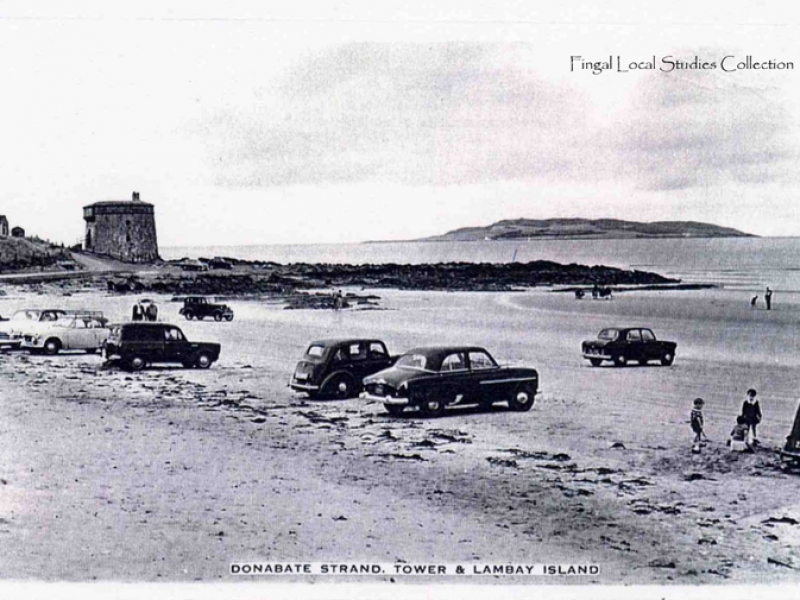The Gobbán Saor and Donabate
According to local tradition the Gobbán Saor is associated with the Turvey area in Donabate (Bates 1988: 18; https://www.logainm.ie/en/1436734 ). This association comes from a dindshenchas (place lore) poem recorded in a medieval manuscript. This poem is called Tráig Thuirbe (Tuirbe’s Strand) and it goes:
- Tuirbe's Strand, exalt its name, to bind it fast, as authors tell: Tuirbe trágmar, famed above all shores, was the loving father of bold Gobban.
- When work was over, he would hurl his axe, that rusty grimy henchman, from yellow Tulach Bela against all the flood-tide of the bay.
- As far as he cast his axe, the flood would not rise beyond it; as for Tuirbe of the mighty axes, in the south, none knew whence came his breed or race:
- Unless it were of the nimble swarthy seed that went from Tara, fleeing before warrior Lug: none that met him then knew whence he came, the man of skill from Tuirbe's Strand.
(The Metrical Dindshenchas, poem/story 61)
Tuirbe (anglicized as Turvey) Trágmar is an obscure figure who is not widespread within the folkloric or mythological traditions of Ireland. The name Tuirbe is possibly related to the word tuir for pillar or column, which was used to describe significant people such as chieftains (eDIL s.v. 1 tuir). Trágmar comes from the word Tráig means shore or strand but can also refer to a measurement or division of land (eDIL s.v. tráig; eDIL s.v. 1 traig). It is clear from these meanings that the figure of Tuirbe Trágmar is one connected to the location of Turvey, and he may be a personification of this place.
In this poem Tuirbe is given as the father of the Gobbán Saor a famous figure within Irish folklore. He usually appears as a builder with the Saor element of his name meaning craftsman or wright denoting his role. He is sometimes named St. Gobbán in the context of building churches with many around the country called Kill Gobbán after him. Gobbán is a diminutive form of Goibniu which stems from the word gobae meaning smith (eDIL s.v. gobae; O hOgain 1991: 241; Rees 1961: 52). Goibniu the smith was one of the four craftsmen of the Tuatha de Danaan in Irish mythological tradition.
This connection to smithing is striking in relation to the poem which describes Tuirbe casting axes into the water of the strand. No archaeological remains suggestive of metalworking or axe production have been found in the Turvey area. However, it is worth noting the remains of Neolithic stone axe production on Lambay Island (Cooney 2009). This activity predates the poem by several millennia and there is no direct connection between the two. However, both the archaeological remains of Lambay and the poem may indicate a long tradition of the significance of axe production along the Fingal coastline. It is unlikely that any further archaeological evidence from the Turvey will be unearthed soon considering the area along with the Rogerstown Estuary has been developed into a beautiful nature reserve. So, the origins and nature of the connections between the Gobbán Saor, smithing and the Turvey landscape will have to remain a tantalizing mystery for now!
Want to Delve Deeper?
If you want to explore other dindshenachas poems visit CELT.ie. If you would like to find out more about the figures of Gobbán and Goibniu listen to an excellent discussion on the Story Archaeology podcast. Or now that summer is upon us why not spend the day exploring at Turvey Park!
-
- Aoife Walshe
Bibliography
Bates, Peadar (1988), Donabate and Portrane: A History, Drogheda.
Carmody, Isolde; Thompson, Kris (2013), ‘The Battle of Moytura 05: Inna Céthoir Cerdi – The Four Craftsmen, accessed through https://storyarchaeology.com/the-battle-of-moytura-05-inna-cethoir-cerd…;
Cooney, Gabriel (2009), ‘The Prehistory of Lambay, a long view’, Axes, Warriors and Windmills: Recent Archaeological Discoveries in North Fingal, ed. Baker, Christine, accessed through https://www.fingal.ie/sites/default/files/2019-04/Axes%2C%20Warriors%20…
EDIL-Electronic Dictionary of the Irish Language, accessed through http://www.dil.ie/
MacNeill, Marie (1962), The Festival of Lughnasa: A Study of the Survival of the Celtic Festival of the Beginning of Harvest, Dundalk.
O hOgain, Daithi (1991), Myth, Legend and Romance: An Encyclopedia of the Irish Folk Tradition, England.
The Placenames Database of Ireland, accessed through https://www.logainm.ie/ga/17019.
Rees, Alwyn; Reese, Brinley (1961), Celtic Heritage, Great Britain.
The Metrical Dindshenchas, poem/story 61, trans. Gwynn, Edward, accessed through https://celt.ucc.ie/publishd.html.
